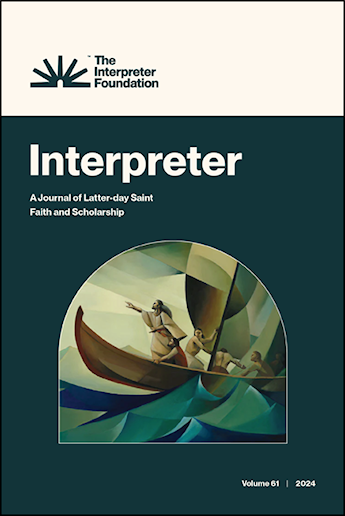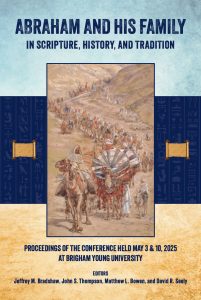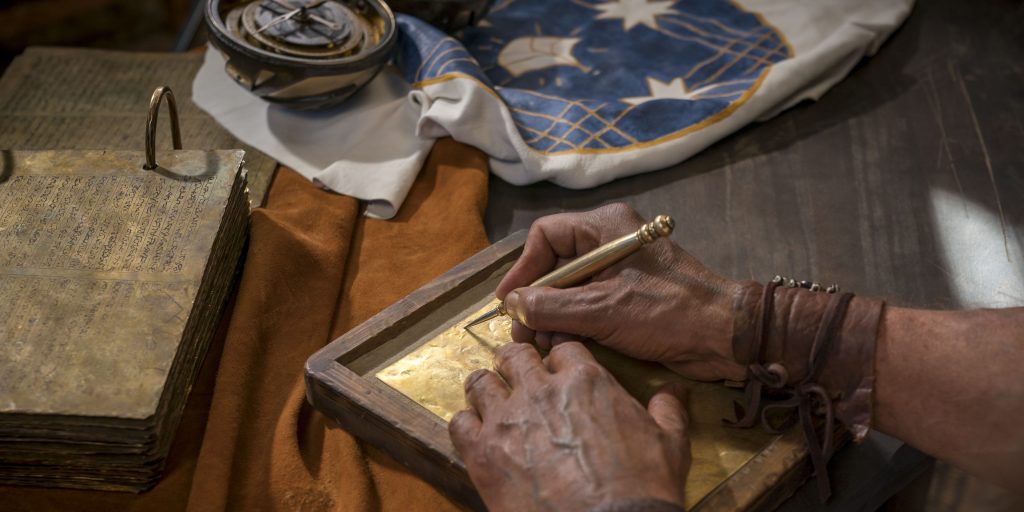[Page 13]Abstract: This article is the third in a series of three articles responding to the recent assertion by Jonathan Neville that Benjamin Winchester was the anonymous author of three unsigned editorials published in Nauvoo in 1842 in the Times and Seasons. The topic of the unsigned editorials was the possible relationship of archeological discoveries in Central America to places described in the Book of Mormon narrative. The first article shows that, contrary to Neville’s claims, Winchester was not a proponent of a Mesoamerican setting for the Book of Mormon, but rather a hemispheric one. Since this was a view commonly held by early Mormons, his ideas did not warrant any anonymity for their dissemination. The second article shows that, also contrary to Neville’s claims, Joseph Smith was not opposed to considering Central American geographic parallels to the Book of Mormon. The Prophet even seemed to find such possibilities interesting and supportive of the Book of Mormon. This third article shows that despite Neville’s circumstantial speculations, the historical and stylometric evidence is overwhelmingly against Winchester as the author of the Central America editorials. Continue reading
 Welcome to Interpreter: A Journal of Latter-day Saint Faith and Scholarship, the peer-reviewed journal of The Interpreter Foundation, a nonprofit, independent, educational organization focused on the scriptures of The Church of Jesus Christ of Latter-day Saints. Non-print versions of our journal are available free of charge, with our goal to increase understanding of scripture. Our latest papers can be found below.
Welcome to Interpreter: A Journal of Latter-day Saint Faith and Scholarship, the peer-reviewed journal of The Interpreter Foundation, a nonprofit, independent, educational organization focused on the scriptures of The Church of Jesus Christ of Latter-day Saints. Non-print versions of our journal are available free of charge, with our goal to increase understanding of scripture. Our latest papers can be found below.
Interpreter's Mission Statement →
Read the journal →
Learn more about the Board →
Find out how you can donate →
Contact the Editorial Board →

Church History and Great Britain with the Interpreter Foundation 14-Day Land Tour escorted by Dan Peterson, Kristine Frederickson, and Peter Fagg May 6-19, 2026 This tour will sell out fast so book your reservation now! Go to https://interpreterfoundation.org/study-travel/britains-2026/ for more information |
|
Abraham and His Family in Scripture, History, and Tradition Proceedings of the Conference held May 3 & 10, 2025 at Brigham Young University Sponsored by The Interpreter Foundation, Edited by Jeffrey M. Bradshaw, John S. Thompson, Matthew L. Bowen, & David R. Seely Published by The Interpreter Foundation and Eborn Books For more information, go to https://interpreterfoundation.org/books/abraham-and-his-family/ |
|
Call for Proposals “For a Wise Purpose in Him” Perspectives on the Small Plates of Nephi A Conference on the Small Plates of Nephi in the Book of Mormon May 29-30, 2026 Sponsored byThe Interpreter Foundation Go to https://interpreterfoundation.org/conferences/2026-small-plates-of-nephi/ for more information |
You More than Owe Me This Benefit: Onomastic Rhetoric in Philemon
[Page 1]Abstract: Wordplay and punning involving the names Philemon (Φιλήμων, “affectionate one”) and Onesimus (Ὀνήσιμος, “useful”) and their meanings, with concomitant paronomasia involving the name-title Χριστός (Christos) and various homonymic terms, constitutes a key element in Paul’s polite, diplomatic, and carefully-worded letter to Philemon, the Christian owner of a converted slave named Onesimus. Paul artfully uses Philemon’s own name to play on the latter’s affections and to remind him that despite whatever Onesimus may owe (ὀφείλει, opheilei) Philemon, Philemon more than owes (προσοφείλεις, prosopheileis) his very self — i.e., his life as a Christian and thus his eternal wellbeing — to Paul. Hence, Philemon “more than owes” Paul his request to have Onesimus — who was once “useless” or “unprofitable” and “without Christ,” but is now “profitable” and “well-in-Christ” — as a fellow worker in the Gospel. In a further (polyptotonic) play on Onesimus, Paul expresses his urgent desire to “have the benefit” (ὀναίμην, onaimēn) of Onesimus in the Lord out of Philemon’s own free will and with his blessing, since all three are now brothers in Christ, and thus slaves to Christ, their true “master.” In the context of Paul’s use of –χρηστός (–chrēstos) and ὀναίμην (onaimēn), Paul’s desire for Philemon’s voluntary “good deed” or “benefit” (τὸ ἀγαθόν σου, to agathon sou) is to be understood as the granting of Onesimus and as the point and climax of this publicly-read letter. Continue reading
Toward Ever More Intelligent Discipleship
[Page vii]Abstract: The temporarily rather comfortable “fit” between the Restored Gospel and American civic religion is a thing of the past, and we contemporary Latter-day Saints seem to find ourselves in a more and more marginalized position, theologically and socially. This was where our predecessors, both earlier in this dispensation and among the first Christians, were located, and it may not be an altogether bad thing. It will, for instance, force us to take our beliefs more seriously, less casually. And it may well drive us back to the unique resources provided by the Restoration, which have much to offer. Continue reading
The Theory of Evolution is Compatible with Both Belief and Unbelief in a Supreme Being
[Page 261]Abstract: The crux of the creation–evolution conflict is a futile desire to scientifically prove or disprove the existence of God. The conflict is manifest in the common belief that creation means a divine, supernatural process and that evolution denotes an atheistic, accidental event. Evolution involves a random change in an inherited trait followed by selection for or against the altered trait. If humans use this principle to design machines, solve complex mathematical problems, engineer proteins, and manipulate living organisms, then certainly a super-intelligent being could have used evolution to create life on earth. This reasoning indicates that evolution does not prove atheism and that evolution is a constructive process. The theory of evolution is a mechanistic description and therefore, like all other scientific principles, is neutral on the question of God’s existence. Evolution is compatible with the simple scriptural accounts of creation. Consequently, belief or unbelief in God is put back where it should be — on individual choice. Continue reading
A Treasure Trove of Questions
[Page 255]A review of James E. Faulconer, The New Testament Made Harder: Scripture Study Questions. The Neal A. Maxwell Institute for Religious Scholarship, 2015, 518 pages with endnotes. $21.95 (paperback).
Abstract: The New Testament Made Harder is a book that collects study questions that follow the Gospel Doctrine reading schedule. The book contains very little commentary and does not provide answers to the questions posed. The main objective is not to provide information, but rather to encourage students of the New Testament to think more deeply about what they are reading. For those who are willing to put forth the effort, they will find this book to be a helpful tool in learning to analyze the scriptures more closely.
John Bernhisel’s Gift to a Prophet: Incidents of Travel in Central America and the Book of Mormon
[Page 207]Abstract: The claim that God revealed the details of Book of Mormon geography is not new, but the recent argument that there was a conspiracy while the Prophet was still alive to oppose a revealed geography is a novel innovation. A recent theory argues that the “Mesoamerican theory” or “limited Mesoamerican geography” originated in 1841 with Benjamin Winchester, an early Mormon missionary, writer, and dissident, who rejected the leadership of Brigham Young and the Twelve after 1844. This theory also claims that three unsigned editorials on Central America and the Book of Mormon published in the Times and Seasons on September 15 and October 1, 1842, were written by Benjamin Winchester, who successfully conspired with other dissidents to publish them against the will of the Prophet. Three articles address these claims. The first article addressed two questions: Did Joseph Smith, as some have claimed, know the details of and put forth a revealed Book of Mormon geography? Second, what is a Mesoamerican geography and does it constitute a believable motive for a proposed Winchester conspiracy? This second article provides additional historical background on the question of Joseph Smith’s thinking on the Book of Mormon by examining the influence of John L. Stephen’s 1841 work, Incidents of Travel in Central America, upon early Latter-day Saints, including Joseph Smith. Continue reading
The Treason of the Geographers: Mythical “Mesoamerican” Conspiracy and the Book of Mormon
[Page 161]Abstract: The claim that God revealed the details of Book of Mormon geography is not new, but the recent argument that there was a conspiracy while the Prophet was still alive to oppose a revealed geography is a novel innovation. A recent theory argues that the “Mesoamerican theory” or “limited Mesoamerican geography” originated in 1841 with Benjamin Winchester, an early Mormon missionary, writer, and dissident, who rejected the leadership of Brigham Young and the Twelve after 1844. This theory also claims that three unsigned editorials on Central America and the Book of Mormon published in the Times and Seasons on September 15 and October 1, 1842 were written by Benjamin Winchester, who successfully conspired with other dissidents to publish them against the will of the Prophet. Three articles address these claims. This first article addresses two questions: Did Joseph Smith, as some have claimed, know the details of and put forth a revealed Book of Mormon geography? Second, what is a Mesoamerican geography and does it constitute a believable motive for a proposed Winchester conspiracy? Continue reading
Learning Nephi’s Language: Creating a Context for 1 Nephi 1:2
[Page 151]Nephi’s Language Without Context: An Enigma
It was not long after the Book of Mormon was published before Nephi’s statement that he wrote using “the learning of the Jews and the language of the Egyptians” (1 Nephi 1:2) started raising eyebrows.1 It has continued to perplex even the best LDS scholars, who have put forward no fewer than five different interpretations of the passage.2 Some have even pointed out that there seems to be no logical reason for Nephi’s statement, since anyone who could read the text would know what language it was written in.3 Continue reading
Not Leaving and Going On to Perfection
[Page 131]A Review of Samuel M. Brown’s First Principles and Ordinances: The Fourth Article of Faith in Light of the Temple, Provo, UT: Neal A. Maxwell Institute, 2014. 167 pp., index. $16.95.
In his most recent book, First Principles and Ordinances: The Fourth Article of Faith in Light of the Temple (hereafter First Principles), Samuel M. Brown observes that “the Plan of Salvation [is] fundamentally about relationships.”1 This recognition drove the prophet Joseph Smith and early Church members to “forge communities [of saints] that could endure beyond the veil of death” (151). Today, the importance of the temple and its ordinances to family relationships, eternal in their design, are clear to most Latter-day Saints. However, our collective view of the meaning of the principles and ordinances that precede the temple — and lead us to it — is somewhat murkier. Brown demonstrates that what Latter-day Saints sometimes perfunctorily regard merely as “the first principles and ordinances of the gospel” (Articles of Faith 1:4) are — every bit as much as the temple itself is — about relationships. In fact, one cannot fully contextualize the temple and its ordinances unless one understands this aspect of the first principles and ordinances of the gospel. Continue reading
The Doctrine of Resurrection in the Book of Mormon
[Page 101]Abstract: The doctrine of resurrection was taught by Lehi and Jacob among the first Nephites but was not mentioned again in the record until the time of Abinadi, perhaps 350 years later. In the court of King Noah that doctrine and the idea of a suffering Messiah who would bear the sins of his people and redeem them, were heresies and Abinadi paid for them with his life. While Abinadi’s testimony converted Alma1 and the doctrine of the resurrection inspired Alma2 after his conversion, it was a source of schism in the church at Zarahemla along lines that remind us of the Sadducees at Jerusalem. The doctrine of the resurrection taught in the Book of Mormon is a precursor to the doctrine now understood by the Latter-day Saints in the light of modern revelation. One example is that the Nephite prophets used the term first resurrection differently than we do. But perhaps the most remarkable thing about the way that the doctrine of resurrection develops in the Book of Mormon, is that it develops consistently. That consistency bears further testimony to the prophetic mission of Joseph Smith. He could not have done that by himself. Continue reading
The Deuteronomist Reforms and Lehi’s Family Dynamics: A Social Context for the Rebellions of Laman and Lemuel
[Page 87]Over the last few years, several Latter-day Saint scholars have commented on how the socio-religious setting of Judah in the late-seventh century bc informs and contextualizes our reading of the Book of Mormon, especially that of 1 and 2 Nephi. Particular emphasis has been placed on how Lehi and Nephi appear to have been in opposition to certain changes implemented by the Deuteronomists at this time, but Laman’s and Lemuel’s views have only been commented on in passing. In this paper, I seek to contextualize Laman and Lemuel within this same socio-religious setting and suggest that, in opposition to Lehi and Nephi, they were supporters of the Deuteronomic reforms. Continue reading
The Prodigal’s Return to the Father: House of Glory and Rediscovery
[Page 75]Review of S. Michael Wilcox. House of Glory: Finding Personal Meaning in the Temple, 1995. Salt Lake City: Deseret Book. 146 pp. with bibliography and index. $14.99 (paperback).
Abstract: The temple of God is a new experience with any visit, but its wonders are nigh astonishing to someone who has lost the privilege for a long time. Wilcox’s House of Glory is more than a guidebook to the House of God, it is a camera panning from the physical (such as the meanings of symbols and the appearances in and outside of temples) to the intensely personal (like the requirements and rewards of temple work, its ancient history, its powers of protection, and so on). Essentially a book for the experienced temple goer (one no longer stunned by the newness of it all), Wilcox’s prize-winning book fills in the blank spaces and answers questions. And awes the Prodigal Son. Continue reading
Careless Accounts and Tawdry Novelties
[Page 63]Review of Lofte Payne. Joseph Smith the Make-Believe Martyr: Why the Book of Mormon Is America’s Best Fiction. Victoria, BC, Canada: Trafford Publishing, 2006. xxi + 331 pp., with appendix and index. $23.10 (paperback).
Abstract: The faith of Latter-day Saints is rooted in Joseph Smith’s recovery of the Book of Mormon, which presents itself as an authentic ancient text and divine special revelation. Book-length efforts to explain away these two grounding historical claims began in 1834, and have never ceased. They are often the works of disgruntled former Saints. In 1988 Loftes Tryk self-published an amusing, truly bizarre, seemingly countercult sectarian account of the Book of Mormon. In 2006, now under the name Lofte Payne, he again opined on Joseph Smith and the Book of Mormon. He discarded the notion that Joseph Smith was a demon. He now claims that the Book of Mormon was Joseph’s sly, previously entirely unrecognized covert effort to trash all faith in divine things. In this review, Payne’s explanation is compared and contrasted with books by Alan D. Tyree, a former member of the RLDS First Presidency, and Dale E. Luffman, a recent Community of Christ Apostle, as well as that of Robert M. Price, a militant atheist, and Grant Palmer, and also the Podcraft of John Dehlin, all of whom have in similar ways opined that the Book of Mormon is frontier fiction fashioned by Joseph Smith from ideas floating around his immediate environment. Continue reading
A Response to Denver Snuffer’s Essay on Plural Marriage, Adoption, and the Supposed Falling Away of the Church – Part 2: Façade or Reality?
[Page 31]Abstract: Part 2 of this response to Denver Snuffer’s essay entitled “Plural Marriage” posted on March 22, 2015, will primarily address non-plural marriage issues as discussed in the last twenty pages.1 Snuffer’s portrayal of adoption teachings and practices is analyzed and shown to be in error, along with his interpretation of presiding priesthood quorums as described in the Doctrine and Covenants. His primary thesis, that The Church of Jesus Christ of Latter-day Saints is in apostasy, is also examined including Snuffer’s personal need for the Church to have fallen away in order to create an opening for his new visionary voice. The lack of evidence supporting such an apostasy is also reviewed including the obvious absence of any prophesied latter-day “dwindling in unbelief.” Snuffer is compared to other dissidents who have come and gone over the past century showing his claims are not unexpected or original. While the Latter-day Saints could be more obedient, a core group of righteous members and leaders has always existed in the Church through which the Lord could perform His restorative works. Continue reading
A Response to Denver Snuffer’s Essay on Plural Marriage, Adoption, and the Supposed Falling Away of the Church – Part 1: Ignoring Inconvenient Evidence
[Page 1]Abstract: Denver Snuffer posted an essay entitled “Plural Marriage” on March 22, 2015. 1 It is apparently a transcription of a recent talk he had given and provides his followers with his views on Joseph Smith and plural marriage. Snuffer’s basic conclusion is that the Prophet did not practice polygamy. He alleges that the historical evidences that support Joseph’s participation should instead be attributed to John C. Bennett’s activities in Nauvoo in 1840–1842 or blamed on Brigham Young’s behaviors and teachings after the martyrdom. This article provides references to dozens of documents that counter this conclusion and shows plainly that Snuffer is in error. On page 28 of the transcript, Snuffer shifts away from the subject of plural marriage, touching on several themes he has written on before. Part 2 of this response will specifically address those twenty pages of Denver Snuffer’s claims. Continue reading
Questioning: The Divine Plan
[Page vii]Some critics of the Church of Jesus Christ of Latter-day Saints, chiefly of the secular variety, claim that Latter-day Saints are mind-controlled robots who are forbidden to think for themselves. I collected an example of this claim nearly twenty years ago that will serve to represent many other such expressions before and since. Continue reading
A Mormon Theodicy: Jacob and the Problem of Evil
[Page 239]Abstract: Lehi’s son Jacob was troubled by a great theological mystery of his and our day — the problem of evil. If God is both all good and all-powerful, how is it possible for the world to be so full of human and natural evils? Jacob was able to elicit from the Lord responses to the question of why He permits evil to flourish in this world. The Lord elucidates the perennial problem of evil for Jacob and us in three distinct genres and at three different levels of abstraction: at a metaphysical level in a philosophical patriarchal blessing, at a concrete level in the history of the emerging Nephite political economy, and in the Allegory of the Olive Tree. Continue reading
Freemasonry and the Origins of Modern Temple Ordinances
[Page 159]Abstract: Joseph Smith taught that the origins of modern temple ordinances go back beyond the foundation of the world.1 Even for believers, the claim that rites known anciently have been restored through revelation raises complex questions because we know that revelation almost never occurs in a vacuum. Rather, it comes most often through reflection on the impressions of immediate experience, confirmed and elaborated through subsequent study and prayer.2 Because Joseph Smith became a Mason not long before he began to introduce others to the Nauvoo endowment, some suppose that Masonry must have been the starting point for his inspiration on temple matters. The real story, however, is not so simple. Though the introduction of Freemasonry in Nauvoo helped prepare the Saints for the endowment — both familiarizing them with elements they would later encounter in the Nauvoo temple and providing a blessing to them in its own right — an analysis of the historical record provides evidence that significant components of priesthood and temple doctrines, authority, and ordinances were revealed to the Prophet during the course of his early ministry, long before he got to Nauvoo. Further, many aspects of Latter-day Saint temple worship are well attested in the Bible and elsewhere in antiquity. In the minds of early Mormons, what seems to have distinguished authentic temple worship from the many scattered remnants that could be found elsewhere was the divine authority of the priesthood through which these ordinances had been restored and could now be administered in their fulness. Coupled with the restoration of the ordinances themselves is the rich flow of modern revelation that clothes them with glorious meanings. Of course, temple ordinances — like all divine communication — must be adapted to different times, cultures, and practical circumstances. Happily, since the time of Joseph Smith, necessary alterations of the ordinances have been directed by the same authority that first restored them in our day. Continue reading
“The Great and Terrible Judgments of the Lord”: Destruction and Disaster in 3 Nephi and the Geology of Mesoamerica
[Page 143]Review of Jerry D. Grover, Jr., Geology of the Book of Mormon. Vineyard, UT: Self-Published, 2014. 233 pp. +xi, including index and references. $39.99.
Abstract: Over recent decades, several Latter-day Saint scholars and scientists have offered analysis and comparison to geologic events and the destruction recorded in 3 Nephi 8-9. Jerry Grover makes an important contribution to this literature as he provides background on geologic processes and phenomena, details the geologic features of the Tehuantepec region (Mesoamerica), and applies this information to not only the description of 3 Nephi 8-9, but other incidents in the Book of Mormon likely connected to geologic events. In doing so, Grover yields new insights into the narratives he examines, and adds clarity to geographic details that have been subject to varying interpretations. Continue reading
Getting Cain and Gain
[Page 115]Abstract: The biblical etiology (story of origin) for the name “Cain” associates his name with the Hebrew verb qny/qnh, “to get,” “gain,” “acquire,” “create,” or “procreate” in a positive sense. A fuller form of this etiology, known to us indirectly through the Book of Mormon text and directly through the restored text of the Joseph Smith Translation, creates additional wordplay on “Cain” that associates his name with murder to “get gain.” This fuller narrative is thus also an etiology for organized evil—secret combinations “built up to get power and gain” (Ether 8:22–23; 11:15). The original etiology exerted a tremendous influence on Book of Mormon writers (e.g., Nephi, Jacob, Alma, Mormon, and Moroni) who frequently used allusions to this narrative and sometimes replicated the wordplay on “Cain” and “getting gain.” The fuller narrative seems to have exerted its greatest influence on Mormon and Moroni, who witnessed the destruction of their nation firsthand — destruction catalyzed by Cainitic secret combinations. Moroni, in particular, invokes the Cain etiology in describing the destruction of the Jaredites by secret combinations. The destruction of two nations by Cainitic secret combinations stand as two witnesses and a warning to latter-day Gentiles (and Israel) against building up these societies and allowing them to flourish. Continue reading



 Conference Proceedings are now available
Conference Proceedings are now available